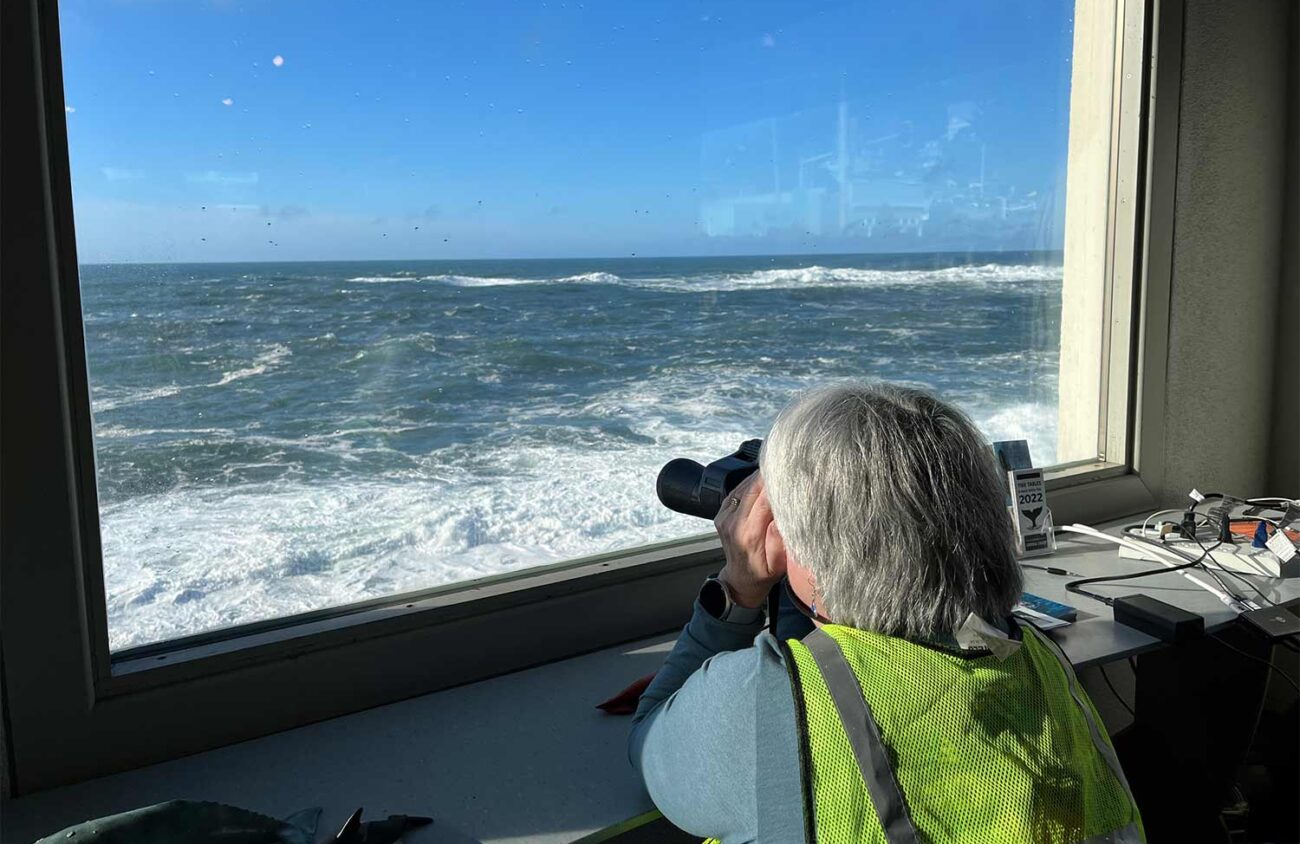Thank gazillions of tiny mysid shrimp for the imminent arrival of about 18,000 massive gray whales just off the Oregon Coast this spring. The inch-long crustaceans inhabit the coastal kelp beds and the whales — baleen filter feeders — show up ravenous. You would think that their winter sojourn in the lagoons of Mexico’s Baja California would involve plenty of chowing down, but you would be wrong.
That’s the kind of thing you’ll learn from volunteers such as retired firefighter Era Horton. He is one of about 150 volunteers who help visitors spot whales during Oregon Whale Watching Week, which runs from Tuesday, March 28, through Sunday, April 2. The good news: These volunteers at 17 sites along the coast stand ready to help you spot the beasts and learn surprising whale facts.
The less good: The state could use about 50 to 60 more volunteers to be available at locations from Fort Stevens near Astoria to Harris Beach near Brookings.
There’s still time to sign up, get some training and participate in the joys of watching Eschrichtius robustus — the 90,000-pound, 45-foot long marine mammals on their journey north to Alaska. Online training sessions will help volunteers be prepared.
Horton, who lives in Salem, ensures that visitors at Boiler Bay, just south of Lincoln City, will be able to tell the difference between random salt spray from the vertical blow-hole blast of a gray whale. This will be his 14th year volunteering with Oregon Whale Watch, a 40-year-old program of Oregon State Parks and Recreation.
What keeps Horton coming back rain and shine, year after year? Well, the whales, of course, but also the people. There is something deeply fulfilling about being there when a visitor sees a whale for the first time, Horton says.
“That’s what really brings me back and loving it, having people who have never seen a whale see one for the first time,” he says. “It’s kind of an incredible experience because of the hollering and the yelling, the excitement you see.… It’s almost like seeing a whale for the first time for me, too. It’s great to feel that I’ve been able to help make their day.”
The volunteers, who get training and who have undergone background checks, can fill in the blanks in people’s knowledge of the habits of gray whales, which spend summers feeding in Alaska waters then migrate to the lagoons of Baja in late fall, where pregnant females give birth while other males and females breed. The whales start migrating northward in February — females with calves the last to leave.
Horton, who is also a member of the American Cetacean Society Oregon Chapter, explains why the spring migration, when whales head north, may be better for viewing than the December southern migration. Gray whales heading south from Alaska have been feeding all summer and fall. They move steadily about three to five miles off the coast. But their feeding strategy — digging into the ocean floor and sucking up tube worms, crab larvae and other such tiny critters that they filter through their baleen — doesn’t work so well in the warmer waters.
They haven’t eaten much in the intervening months and are ready for some serious meals by the time they reach Oregon, where they skim the kelp beds within a mile or so of shore that are chock full of mysid shrimp.
“All of the whales coming back are closer (to shore) because they haven’t eaten since they left,” Horton says.
Horton is happy to share these kinds of details with visitors, but he doesn’t always get the chance.
Watching whales requires some patience, since the animals are on their own schedule — and visitors, especially first-timers, aren’t always willing to wait, he says.
“I see people pull up and before I have a chance to talk with them, I’ll hear a comment like, ‘Oh, there’s nothing here,’ and I’ve been watching a whale for the last hour in front of me. It just happens to be down right now, and they turn around and get in their car and drive off. As they’re driving away the whale comes back up and blows again,” he says.
What folks who don’t linger might also fail to realize is how many other intriguing creatures show up between whale sightings, Horton says. While he’s waiting, he’s seen eagles and seals and dolphins, among other things, and, once, a great white shark.
Besides patience, appropriate clothing is essential, Horton says. There might be sunshine. There might be wind blowing rain horizontally.
Peter McBride, an Oregon State Parks ranger, says the state relies on volunteers like Horton because there simply isn’t enough staff available. While new volunteers at any of the locations are welcome, there’s a particular need for them along the southern coast at places such as Ophir Beach (midway between Port Orford and Gold Beach) and Harris Beach (just north of Brookings).
Several whale-watching sites have shelters — Cape Foulweather, Depot Bay, Cape Perpetua — where folks can view the ocean out of the wind and rain.
As for whether there is a “best” spot for whale watching along the Oregon coast, McBride demurs.
“I’ve spent most of my time on the central coast, so that’s something I gravitate to. But honestly the whole coastline is beautiful. I couldn’t just pick one,” he says.
For more information on whale watching, see ORWhaleWatch.org. To volunteer, see ORWhaleWatch.org/volunteer. For more about whales, see Facebook.com/ACSOregonChapter
Susan Palmer is a Eugene writer. See more of her work at SusanPalmer.org. This story was produced in cooperation with YachatsNews.com.
